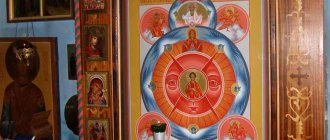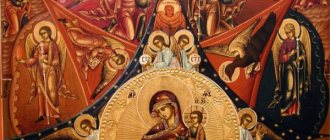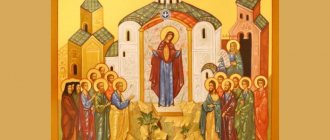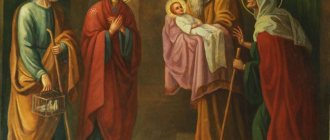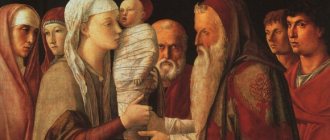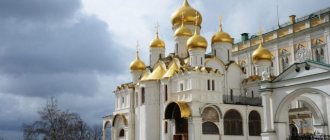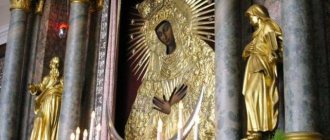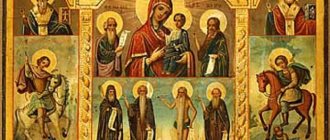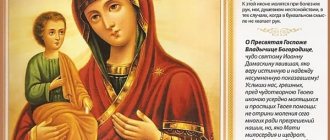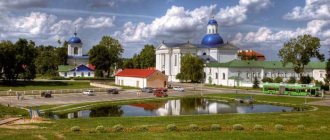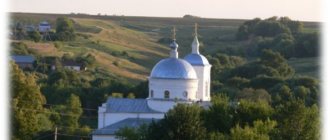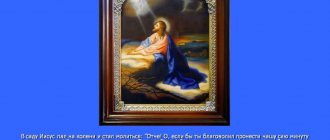Many people believe in God, but not everyone has extensive knowledge regarding religion. Christianity is based on the belief in one Lord, but the term “trinity” is often used and few know what it really means.
Origin story
The basis for creating the iconographic image of the Trinity was a description from the Book of Genesis, known as “The Hospitality of Abraham.” It tells of Abraham's meeting with three angels, a trinity, who informed him of the imminent birth of his son.
This thought became the cornerstone in the foundation of Christian dogmatism. The Holy Trinity is a symbol of the trinity of God. There are several icons depicting the Holy Trinity. Each of them has distinctive features.
When and to whom did the Holy Trinity first appear?
One of the most important holidays for Christians is the Epiphany and it is believed that during this event the first appearance of the Trinity took place. According to legend, John the Baptist in the Jordan River baptized people who repented and decided to come to the Lord. Among all those who wished to do so was Jesus Christ, who believed that the Son of God must fulfill human law. At the moment when John the Baptist baptized Christ, the Holy Trinity appeared: the voice of the Lord from heaven, Jesus himself and the Holy Spirit, who descended in the form of a dove to the river.
Significant is the appearance of the Holy Trinity to Abraham, to whom the Lord promised that his descendants would become a great nation, but he was already old, and he never had children. One day, he and his wife, while in the oak grove of Mamvre, pitched a tent, where three travelers came to him. In one of them, Abraham recognized the Lord, who said that he would have a son next year, and so it happened. It is believed that these travelers were the Trinity.
Meaning in Orthodoxy
At first, all the participants in the meeting were present in the images: the trio of travelers, Abraham, and his wife Sarah. Later, noticeable changes took place; icon painters emphasized the trinity, because they became the personification of the highest heavenly powers. The book of Genesis tells the story of Abraham's meeting, describing the details. After the announcement of the birth of a son who would give continuity to the entire Jewish people, two wanderers went to Sodom and Gomorrah, and one of the travelers remained with Abraham.
In the New Testament, the name of Abraham is often mentioned when describing the earthly genealogy of Jesus Christ. He is called “the son of Abram’s seed,” which implies Abraham’s awareness of the descent of the Divine Son to earth. There are several options for depicting the Holy Trinity, which have a special meaning:
- the angels of the Trinity are depicted as equal in dignity, which means the complete trinity of the persons of God;
- the middle angel from the Trinity is distinguished by drawing the details of clothing, which speaks of the true appearance of God the Father.
Triquetra: dot the i's
The triquetra symbol (sometimes called triquetra), whose meaning goes deep into the past of Northern Europe, has a controversial history. In fact, we don’t even know exactly what we call the phrase “triquetrum symbol” (or “triquetra symbol”), because the word “triquetrum” itself is of Latin origin (from “tri” - “three” and “quetrum” - having corners). That is, we do not know the original name of the symbol used by the Celts, Scandinavians, British, Germans or Slavs.
Another conceptual aspect should be immediately noted: the symbol of the triquetra (along with the word “triquetra” it is also fair to use the word “triquester”, a variation of the original Latin name) is relatively neutral, or we believe that it is neutral. Probably, for the peoples of Northern and, perhaps, Central Europe, the triquetra was a universal sacred sign, but no reliable information about its purpose and functions has reached us. That is, we do not know the original meaning of the triquetra, but there are many archaeological artifacts on the basis of which we can build various theories. Moreover, the meaning of the triquetra appears to have changed over time.
The first finds depicting the triquetra symbol date back to the Bronze Age (33rd – 11th centuries BC). In all likelihood, for the ancient peoples of Britain and Scandinavia, the triquetra personified the phases (not movement!) of the Sun, in particular - sunrise, zenith and sunset. In this connection, the triquetra symbol is often personified by the norns Urd, Verdandi and Skuld or the aesirs Odin, Vili and Vyo, but this is not even a hypothesis, because there is no direct or indirect indication of such a semantic connection. But there are theories that connect the triquetra (a photo of the symbol in its variations is presented below) with the phases of the moon and even cyclical life processes, which is not without meaning. But do not be mistaken, the same Celts could well have used the triquetra as an element of the lunar calendar, but there is not and cannot be any connection with occultism and Wiccans, who for just over half a century have been practicing rituals associated with the universal creative principle - the Triune Lunar Goddess, whose image , however, is indeed adopted from Celtic traditions.
The presence of the triquetra symbol on numerous runestones of the British Isles and the Scandinavian Peninsula suggests that the Celts, Frisians and Scandinavians really attached special meaning to it. For example, the Irish probably associated the triquetra with Manannan Mac Lir. In the Scandinavian (later German) tradition, the triquetra symbol is obviously associated with the god Thor. In Rus', the triquetra had practical significance; it was often carved on household objects as a spectacular (perhaps a talismanic) decoration. It is assumed that the Slavs adopted the triquetra from the Scandinavian mercenaries, who used it everywhere - from painting on utensils to carved patterns on longships.
The triquetra is depicted on the coins of the first rulers of York, who, although they were Christians, still came from the legendary Scandinavian family of Ynglings. Also, the Scandinavian king Harald the Severe (died in 1066 at the Battle of Stamfordbridge) issued silver coins with the traditional (as we now call it Celtic) triquetra.
In the Spassky Cathedral of Chernigov in 1923, silver bracelets of the 12th century were discovered, which depict a triquetra, on both products it is located between a lion and a lioness. Some researchers believe that the lion and lioness here are an allegory of the masculine and feminine principles, and the triquetra is a family hearth, or passion (love?) that unites them.
Iconography
Each of the icons dedicated to the appearance of the Holy Trinity has special characteristic features. The only thing that unites all the images is the prototype, that is, the meeting of Abraham and the Trinity that became the basis.
Zyryanskaya
This image was created by Saint Stephen. The signature is made in the language of the Komi people, the icon has distinctive features:
- the board depicts the Holy Trinity from the Old Testament;
- three angels sit at the table;
- below there are images of Abraham and Sarah;
- the cup on the table speaks of the sacrament of communion;
- three oak branches emphasize the idea of trinity.
Old Testament
The basis was the images on the walls of the Roman catacombs. They depicted Abraham's equal companions in identical clothes, as well as the most hospitable host, who was located just below the guests and appeared in the form of a layman bowing his head.
Rubleva
The most famous icon of Andrei Rublev, which is considered to have distorted the canon and laid the foundation for a new understanding. One of the features of the image is the use of sunny and light colors. This list has become one of the outstanding achievements of Russian icon painting.
The semantic and symbolic center of the icon was the image of a cup on the refectory table, reminiscent of the Eucharist. This is an emphasis on the sacrifice of Jesus, the taking of sins upon oneself and the upcoming torment at Calvary.
Simona Ushakova
The basis for the image was “The Holy Trinity” by Andrei Rublev with some changes. The angelic trinity is drawn in such a way as to convey the frailty of existence and the materiality of the earthly world. The refectory table is filled with plates with dishes and jugs.
The mention of the existential nature of the meeting made this icon a secular image, belittling its Christian significance. “Trinity” by Simeon Ushakov is kept in the Tretyakov Gallery.
In being
The scenes of life are composed of depictions of Abraham's hospitality, the creation of Adam and Eve, the building of Noah's ark, as well as other life stories. The canvas depicts oak branches, Abraham, Sarah, and the refectory table assembled by the owner for the messengers.
Old Testament with walking
Walking symbolizes:
- the announcement of the news of the birth of the son Isaac;
- delivering Sodom and Gomorrah to punishment.
The walking is schematically emphasized by the figures in the background. In addition, the lower part is dedicated to Isaac. The youth sits next to the ram, which was sacrificed later, after God’s request to Abraham.
14th century
The icon of the Holy Trinity was painted by an unknown author. It depicts the triune God in the guise of winged angels. Sarah and Abraham serve at the table, bowing their heads to the guests.
In salary
This is an icon of the Holy Trinity, painted by Andrei Rublev, which is covered with gold or frame. The technique of concealing details dates back to the reign of Ivan the Terrible, and under Boris Godunov, sapphire decoration was added to the gold canvas. The sediment was completely removed in the first half of the 20th century by restorers. Under a layer of gold they discovered the legendary Rublevsky icon of the Holy Trinity.
Titian
Titian's image of the Holy Trinity belongs to the group of secular icons. The Father and Son with the Holy Spirit are seated in heaven with symbols of power in their hands, and angels are located at their feet, awaiting instructions.
Renaissance
The Holy Trinity is also depicted as a private conversation between God the Father and the Son. At the same time, God points to the presence of the incorruptible Holy Spirit in the distance. The Holy Trinity is surrounded by cherubs, the heavens are painted bright and clear.
New Testament
The New Testament Trinity is interpreted in one of two ways:
- Co-throne. The elder father talks with his son, as the earthly Jesus is portrayed. The Holy Spirit hovers near the elder's shoulder.
- Fatherland. The father sits on the throne, holding the baby Jesus on his lap, who is clutching a sphere with the image of a dove, a symbol of the Holy Spirit.
Information! After the synod, which took place in the second half of the 16th century, images of God were prohibited, so the New Testament icons of the Holy Trinity did not become widespread.
Non-canonical images
There are many lists and secular icon paintings that reveal the symbolism of the Holy Trinity beyond the canonical understanding. The names of many painters became known thanks to canvases on religious themes.
Coronation of Our Lady
The issue of canonizing the Virgin Mary worried many Christians. It is believed that she was crowned and after her death ascended to heaven. The most famous paintings are those on which:
- the Virgin Mary is crowned by the Father and the Son in heaven;
- The Virgin Mary is crowned by Jesus, and the angels trumpet solemn chants.
Worship of the Holy Trinity
The creation of an extensive panorama dedicated to the Holy Trinity dates back to the first half of the 16th century. It represents the crucified Christ, the Father with his arms stretched out over the Son, and the Holy Spirit as a soaring dove. Below are depicted the people saved by the sacrifice of Jesus who remained on earth after the Day of Judgment.
Fresco by Masaccio
A masterpiece of Renaissance painting dedicated to the Holy Trinity, it is a fresco showing a crucifixion scene. Above the head of Christ is the Father, and at his feet rests the coffin with the relics of Adam. On either side of the cross the mother of Jesus and Saint John are praying.
Hieronymus Cocido
The medieval tradition of depicting the trinity is a drawing of one face with three pairs of eyes, three lower parts of the face. This style became obsolete several decades after its appearance. The founder of this technique with the image of the Holy Trinity was Hieronymus Cocido.
Slavs
- one of the most important holidays of the Orthodox church calendar, celebrated on the 50th day after Easter (hence its second name - Pentecost). In folk tradition, T. is included in the complex of several holidays. For the Russians, it began with Semik, that is, Thursday of the seventh week after Easter; The next notable date of this cycle is the Saturday on the eve of T., celebrated among the Eastern Slavs as one of the main memorial dates of the year (cf. the names of this day: “parental Saturday”, “suffocating” or “spiritual Saturday”, “Trinity grandfathers”). Following Trinity Sunday, a week began, called by the Eastern Slavs “Trinity”, “Rusal”, “Wired”, etc., and by the Catholic Slavs “Green Christmastide” or “Green Week”. In its composition, two main dates stood out: Spiritual Day and Thursday, called in the southern Russian regions and in the Polesie zone “Trinity of the Dead”, “Navskaya Trinity”, “Rusalchin Great Day”. In popular beliefs, this period of the calendar was perceived as harmful and dangerous (cf. its Polesie names: “harmful” or “crooked” week); people born at this time were predicted to have an unhappy fate, and those who died were predicted to become “unclean” spirits. Judging by some folklore texts and beliefs, the “Holy Trinity” was represented as a single female character. Dedicated to these days, the folk custom of decorating houses, outbuildings, churches, courtyards and village streets with fresh greenery is common to all Slavs (both Orthodox and Catholic). On the eve of Pentecost, “Trinity greens” were prepared: people brought whole carts of cut branches and young trees, herbs and flowers. Ritual wreaths were woven from them; this greenery was used to cover the floors of houses and churches; branches were stuck into windows and doors of houses, into gates and fences, and hung over wells; the trees were buried in the yard near the house, under the windows, in the corners of the house, along rural streets, etc. After three days, all the “Trinity” greenery was taken outside the living space and destroyed in ritual ways: floated on water, burned in ritual bonfires, thrown onto trees or roofs of houses. The remains of dried herbs and branches were preserved as a remedy or a talisman against evil spirits, natural disasters, rodents and insects. The customs of the Semitic-Trinity cycle among the Russians were especially widespread and ubiquitous, among them the well-known rituals with the “Trinity” birch tree stood out. In Semik, girls went into the forest to “curl” birch trees: they twisted the branches into rings, fastening them with ribbons (see Birch). At the same time, a rite of communion was performed, that is, girls kissed in pairs through such birch circles and exchanged their crosses or other things while singing special songs (“Let’s kiss, godfather, let’s kiss, so that we don’t fight with you...”), after which they called each other friend's godfather. On Trinity Day, they came to this place again, untied the birch branches and “spent money”, returning their things. An important element of the Trinity cycle are funeral rites, most pronounced among the Eastern and Southern Slavs. In the Russian North, T. and the previous Saturday were considered the main memorial dates of the year. In church sources of the 16th-18th centuries. the folk custom was condemned when “on Trinity Saturday, husbands and wives gather around the village and churchyard in mourning and mourn over the graves of the dead with a great cry.” The Saturday before T. was considered one of the main memorial dates among the southern Slavs (see Zadushnitsy). In the southern Russian regions and Polesie, Friday and Saturday before T. were celebrated as days when it was possible to remember the “unclean” dead. In the Chernihiv region they said that these were the main memorial “grandfathers” of the year, when it was imperative to remember all the drowned and hanged people from their family. The customs of commemorating those who died a violent or premature death correlate with beliefs about the appearance on earth at this time of the souls of dead children or girls who did not live to get married, that is, mawoks and mermaids. Parents who experienced the death of unmarried daughters or young children performed funeral rituals especially carefully: they left food intended for souls on the table overnight; they hung clothes for mermaids on the fence; they observed the prohibitions of sewing, spinning, whitewashing the walls of the house and stove, and working in the fields, so as not to harm the invisibly present mermaids. To remember their children who died in infancy, mothers took them to the cemetery and distributed colored eggs and pies to fellow villagers. In the northern regions of Bulgaria, T. and Rusal Week were revered as “a holiday of mermaids and samodivas,” so women refrained from all types of work outside the home, so that the mermaids would not punish them with an incurable disease. This same period was considered the only time in the year when it was possible to cure patients with the “Rusal” or “Samodiv” disease: for this purpose, special ritual persons walked around the village - male squads who performed magical round dances around the patient (see Rusalia). According to widespread beliefs among the Eastern and Southern Slavs, in the last days of the Trinity cycle, the souls of the dead return to the afterlife, therefore, the rituals of this period reflect numerous motives for “farewell” to them and “seeing off”, that is, ushering the dead out of earthly space. For example, the Bulgarian and Macedonian custom of covering the floor of the church with walnut leaves on Spiritual Day was done in order to say goodbye to souls and help the dead cross back to the “other world.” Among the Eastern Slavs, the final stage of the Trinity cycle is characterized by various forms of ritual “seeing off”: for example, the destruction of Trinity greenery; “expelling the mermaid”, “driving the bush” (or “spring”, “poplar”, “duck”); “farewell” to the pair of mummers “Semik and Semichikha”; “funeral of the cuckoo”, etc. Lit.: Sokolova V.K. Spring-summer calendar rituals of Russians, Ukrainians and Belarusians. M., 1979. S. 188-227. L. N. Vinogradova < SMES
Secrets of the Trinity by Andrei Rublev
Rublev’s icon of the “Life-Giving Trinity” contains more than 10 biblical symbols, which are allegorically encrypted by the hand of the master:
- the cup that is on the table is a symbol of the Lord’s communion;
- the head of the cup in the shape of a calf signifies the divine sacrifice;
- the azure color of the clothes of the Holy Trinity speaks of the unearthly essence of those present at the table;
- the tree branches above the heads of each of the Holy Trinity are reminiscent of the oak tree under whose crown Abraham rested; on this icon they are also the personification of the tree of life;
- the schematically depicted mountain is reminiscent of Golgotha, and is also a symbol of redemption.
Reference! Andrei Rublev was canonized after his death.
General information about the triquetra symbol
Triquetra is the oldest sacred symbol in the form of a trefoil.
The Triquetra is an ancient symbol endowed with great power and capable of attracting harmony, tranquility and abundance in all areas of life. It has no religious connection, which is why it is used by different peoples all over the world.
Appearance
Translated from Latin, its name means “having 3 angles” or “triangle”. However, outwardly this symbol does not look like a familiar geometric figure, but resembles 3 petals intertwined, each of which looks like a fish bladder.
During the birth of the Christian religion, he was depicted in the form of 3 intertwined fish. Often a circle is added to the symbol on the outside or inside.
There are 4 types of triquetras:
- Classic (simple) - consists of 3 crossed petals. In some cases they are connected by a circle. This symbol is used more often than others.
- Holy Trinity - used by representatives of Christianity and looks like an interlacing of 3 petals, framed in a triangle and a circle.
- Deaf - forms a closed figure, in the center of which there is a solid thick line.
- Double - is a plexus of 2 identical symbols that are superimposed one on top of the other.
Meaning
In Scandinavian countries, this symbol was associated with the god Thor, the lord of thunder and lightning. To enhance the effect of the amulet, offerings were made to the deity in the form of meat, sweet fruits, and strong alcoholic drinks.
The symbol is associated with the lord of thunder and lightning.
In Rus', this sign personified the movement of the sun across the sky, where one petal indicated sunrise, another indicated noon, and the third indicated sunset. It symbolized all the life phases that a person goes through from birth to death. However, the fact that the rays represent a vicious circle indicates the infinity of life and constant rebirth. This powerful sign is applied to amulets for the following purposes:
- Protect from dark forces, damage and the evil eye.
- Achieve harmony in all areas of life.
- Eliminate negative thoughts and emotions.
- Improve mood.
- Focus on important matters.
- Strengthen your immune system and improve your health.
- Increase self-esteem.
When any magical effect is performed on a person, the amulet will be able to reflect it.
Magic properties
Triquetra has the following magical properties:
- enhances energy and vitality;
- imparts such qualities as perseverance, determination and determination;
- gives confidence in one’s own abilities;
- eliminates any negativity coming from both inside and outside;
- endows its owner with wisdom and foresight.
Triquetra gives confidence and eliminates negativity.
How to pray in front of an icon
Home appeal to the Holy Trinity is associated with compliance with basic rules:
- they prepare for prayers in advance; for newly converted Orthodox Christians, it is permissible to use prayer books with texts;
- for requests, choose early morning, before starting work, or early evening, before dinner;
- To pray, be sure to observe solitude and focus on your thoughts.
Orthodox prayers to the Holy Trinity
There are several prayer texts that can be used to address the Holy Trinity. They must be pronounced in front of an icon, which can be found in churches or bought in a church shop and prayed at home. It is worth noting that you can read not only special texts, but also turn separately to the Lord, the Holy Spirit and Jesus Christ. Prayer to the Holy Trinity helps in solving various problems, fulfilling desires and healing. You need to read it every day, in front of the icon, holding a lit candle in your hands.
Prayer to the Holy Trinity for the fulfillment of desires
You can turn to Higher powers to fulfill your cherished desire, but it is important to take into account that these should not be trivial things, for example, a new phone or other benefits. Prayer to the “Holy Trinity” icon helps only if the fulfillment of spiritual desires is required, for example, you need help in achieving your goals, providing support to a loved one, and so on. You can pray both in the morning and in the evening.
Prayer for children to the Holy Trinity
Parental love for their children is the strongest, because it is selfless and comes from a pure heart, which is why the prayers said by parents have enormous powers. Worshiping the Holy Trinity and saying a prayer will help protect a child from bad company, wrong decisions in life, heal from diseases and cope with various problems.
Prayer to the Holy Trinity for mother
There is no special prayer text intended for children to pray for their mother, but you can read a universal simple prayer that helps convey your sincere requests to the Higher Powers. When figuring out what prayer to read to the Holy Trinity, it is worth noting that the text presented below must be repeated three times, be sure to cross yourself after each and make a bow from the waist. After reading the prayer, you need to turn to the Holy Trinity in your own words, asking for your mother, for example, for protection and healing.
Prayers to the Holy Trinity for the healing of diseases
Many people come to God at a time when they or someone close to them is seriously ill. There is a huge amount of evidence that the Holy Trinity in Orthodoxy helped people cope with various diseases, and even when medicine did not give a chance for recovery. It is necessary to read the prayer in front of the image, which should be placed near the patient’s bed and light a candle next to it. You should contact the Higher Powers daily. You can say a prayer over holy water, and then give it to the patient.
Kabbalah and the Triune World of Creation
The correspondence of the symbol of the Trinity in the Kabbalistic Tree of Sephiroth are the first three Sephira of the system: Kether, Chokmah and Binah. These three spheres are the foundations of the universe: the Absolute, the Great Father and the Great Mother.
- Kether is the Source, the primordial one, called the “Crown”, denoting the great ocean of primordial energy, which subsequently creates all things.
- Chokmah is the first active action, the expression of the will of the Creator.
- Bina is dark, static matter, whose function is to reflect the light of the Almighty and manifested existence in physical form.
The meaning of a tattoo depicting the triquetra symbol
An amulet, unlike a tattoo, can always be removed if any strange sensations arise. Therefore, before stamping a symbol, you should wear it in the form of a pendant around your neck to understand whether it is suitable for its owner in terms of impact and energy.
For men
After applying this tattoo, men gain self-confidence, courage and determination. At the same time, they receive protection from any negative influence coming from outside, including magic. Since the sign is on the body, its impact is significantly enhanced.
A tattoo gives a man confidence and determination.
For women
This sign gives women peace of mind, gives them vitality and energy. They become positive, their internal state is harmonized. Thanks to this, it is easier for them to build relationships with others.
What you can't do on Trinity
You should prepare well for the Orthodox Trinity and thoroughly clean the entire house so that not a single dirty corner remains. Our ancestors believed that if you celebrate the holy festival in cleanliness and order, good luck will not leave you until next year. All this needs to be done the day before.
Work, do laundry, clean, wash, plan global events. According to signs, you cannot move on this day, otherwise you will not get accustomed to the new place. You can’t spend a lot of money or make serious purchases. You cannot argue, swear, or gamble, even if it is a regular table lotto. Anything that involves spending money will not be beneficial.
You cannot prepare holiday dishes; this must be done the day before, on Saturday. Housewives prepared pies for Trinity. A small piece of each such pie should have been dried and stored until the wedding of their children. It is believed that a cracker of Trinity bread will definitely bring good luck and prosperity to the new family.
They tried not to schedule a wedding for this day; it was believed that nothing good would await such a family. But matchmaking and acquaintance on this day is a good sign. Such a marriage will be strong and happy
Interesting Facts
Many amazing phenomena are associated with the ancient symbol. They can be observed in the field of art and esotericism, fashion and sports. Here are just the most striking facts:
- the triquetra graced the cover of Led Zeppelin's 4th album (keyboardist John Paul Jones chose it as a personal amulet and achieved incredible success: he learned to play almost all musical instruments);
- the heroine of the American series “The Walking Dead” Michonne skillfully wields a katana with the image of the Celtic triquetra - “the symbol of the triple goddess”;
- in the German TV series “Darkness” (2017), the trigeminal node allows you to travel through time, symbolizing closed loops of caves, 33 years apart from each other;
- the main element of the cover of the Book of Shadows in the American TV show Charmed - the Celtic triquetra - represents the power of three sisters acting as one;
- in the world of men's fashion, the concept of a “trigeminal knot” is associated with an intricate way of tying a tie;
- the Celtic knot is used as decoration in popular Irish jewelry such as wedding or engagement rings; this is the best reminder to those getting married about the eternity of faith, hope and love;
- The shamrock has become Ireland's most popular symbol, emblazoned on the tail of an airplane and a lamppost, at the entrance to a pub and university, on a postage stamp and on footballers' uniforms.
Triquetra is not just a pattern that came from time immemorial. Connected to the fundamental realms of nature and human existence, the trigeminal node is a unique repository of the power of our ancestors. An ancient sign can become your source of peace and harmony, self-sufficiency and confidence, vital energy and inspiration. All of the above makes the triquetra an ideal personal or family amulet.
Trinity in Taoism
The main symbol of Taoism is the Yin-Yang , depicting trinity as the interaction of opposite principles in a unifying common center. Yin and Yang are two polarities, but also two halves of the whole. The Taoist pantheon is headed by the “three pure ones,” which, by analogy with the symbolism of other traditions, designate the lords of the three worlds:
- Huang Di is the patron of primordial chaos;
- Yu-di - lord of heaven;
- Tai-i tianzun is the ruler of the world of the dead.
Who can use the triquetra as a talisman?
The same amulet will affect each person differently. It depends on physiological and psychological characteristics, health status, as well as emotions and experiences.
However, this ancient symbol has always had a beneficial effect on its owner. There were no negative consequences identified: deterioration in health, accidents or deaths after wearing it. In this regard, the amulet can be worn by different people, regardless of gender, age and religious affiliation.
The symbol affects the subtle body, but it will be difficult for an outside observer to notice. It is necessary to test its strength through personal experience by using the amulet.
Triquetra can be made of any metal, but precious metals are more powerful conductors of pure energy. It is better to give preference to silver or gold items. They need to be properly looked after: every evening, carry out a ritual of cleansing from negative energy using a piece of natural fabric.
Triquetra has a beneficial effect on the owner.
It is recommended to thread the amulet through a thin thread and wear it around the neck. According to observations, it acts as a catalyst: it enhances those qualities that a person possesses to a greater extent. Therefore, it is necessary to monitor your thoughts and actions and avoid unkind thoughts and desires.
